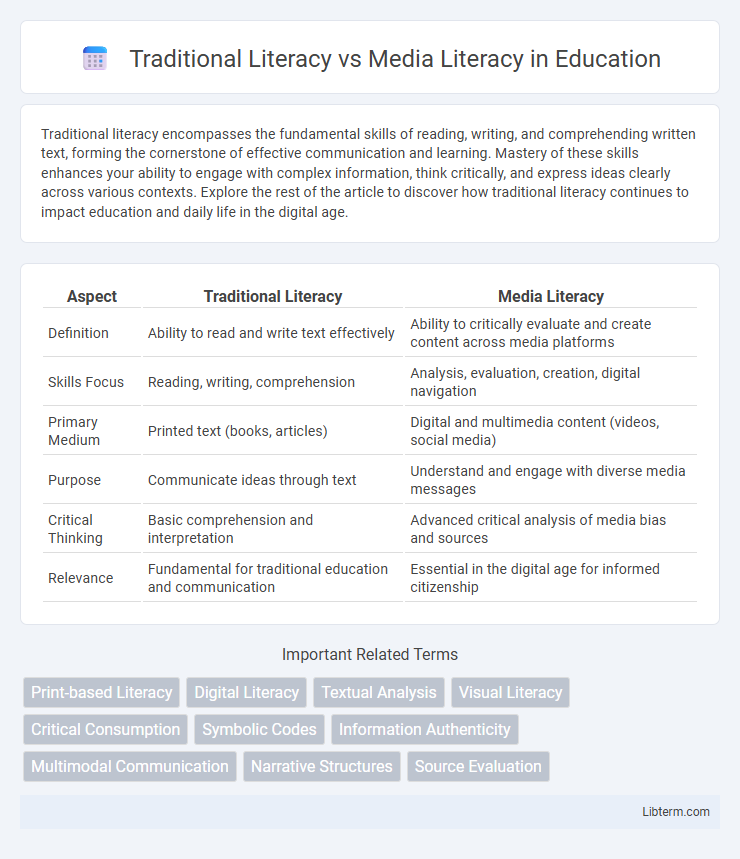Traditional literacy encompasses the fundamental skills of reading, writing, and comprehending written text, forming the cornerstone of effective communication and learning. Mastery of these skills enhances your ability to engage with complex information, think critically, and express ideas clearly across various contexts. Explore the rest of the article to discover how traditional literacy continues to impact education and daily life in the digital age.
Table of Comparison
| Aspect | Traditional Literacy | Media Literacy |
|---|---|---|
| Definition | Ability to read and write text effectively | Ability to critically evaluate and create content across media platforms |
| Skills Focus | Reading, writing, comprehension | Analysis, evaluation, creation, digital navigation |
| Primary Medium | Printed text (books, articles) | Digital and multimedia content (videos, social media) |
| Purpose | Communicate ideas through text | Understand and engage with diverse media messages |
| Critical Thinking | Basic comprehension and interpretation | Advanced critical analysis of media bias and sources |
| Relevance | Fundamental for traditional education and communication | Essential in the digital age for informed citizenship |
Defining Traditional Literacy
Traditional literacy primarily refers to the ability to read, write, and comprehend printed texts, encompassing skills such as decoding letters, understanding grammar, and interpreting written language. It forms the foundation for acquiring knowledge, enabling effective communication and critical thinking in academic and everyday contexts. Developing traditional literacy is essential for functional competence in navigating written information across various domains.
Understanding Media Literacy
Understanding media literacy involves recognizing how to critically evaluate, interpret, and create content across various digital platforms. Unlike traditional literacy, which centers on reading and writing skills, media literacy requires analyzing multimedia messages, discerning bias, and identifying accuracy and credibility. Mastering these skills enables individuals to navigate complex information ecosystems effectively and make informed decisions.
Historical Evolution of Literacy
The historical evolution of literacy reveals a shift from traditional literacy, centered on reading and writing skills crucial for print-based societies, to media literacy, which encompasses critical analysis and understanding of digital and multimedia content. Traditional literacy emerged with the invention of the printing press in the 15th century, enabling mass dissemination of information and fostering educational reforms. In contrast, media literacy gained prominence in the late 20th century alongside the rise of television, the internet, and social media, requiring individuals to interpret diverse and dynamic media formats.
Core Differences Between Traditional and Media Literacy
Traditional literacy centers on reading and writing skills, emphasizing the ability to decode and comprehend printed text, whereas media literacy involves critically analyzing, evaluating, and creating content across various digital platforms and multimedia formats. Traditional literacy primarily develops cognitive skills related to language and text comprehension, while media literacy cultivates digital skills, media production awareness, and an understanding of media influence on public perception. Core differences include the scope of content (text vs. multimedia), skill sets (decoding text vs. critical media analysis), and the interaction with information sources (linear consumption vs. interactive engagement).
Skills Required for Traditional Literacy
Traditional literacy requires the ability to decode and comprehend printed text, including phonemic awareness, vocabulary recognition, and fluency in reading and writing. It involves mastering grammar, syntax, and spelling to effectively communicate and understand written content. These foundational skills enable individuals to interpret and analyze various forms of printed media accurately.
Essential Media Literacy Competencies
Essential media literacy competencies encompass critical thinking skills, the ability to analyze and evaluate diverse media messages, and understanding the influence of media on public opinion and culture. Unlike traditional literacy, which focuses on reading and writing printed text, media literacy requires interpreting multimedia content, recognizing bias or misinformation, and using digital tools effectively. These competencies enable individuals to navigate complex media environments, fostering informed decision-making and responsible communication in the digital age.
The Role of Technology in Shaping Literacy
Technology has revolutionized literacy by expanding it beyond traditional reading and writing to include digital and multimedia skills essential for media literacy. Digital platforms enable individuals to access, analyze, and create diverse content, fostering critical thinking and informed citizenship. The integration of technology cultivates multimodal literacy, empowering users to navigate complex information ecosystems effectively.
Impacts on Critical Thinking
Traditional literacy develops foundational skills in reading and writing that enable individuals to understand and analyze textual information logically. Media literacy expands these capabilities by incorporating the evaluation of multimedia sources, fostering the ability to discern bias, misinformation, and hidden agendas across digital platforms. Together, these literacies enhance critical thinking by equipping individuals with diverse tools to assess credibility, interpret context, and synthesize information from multiple formats.
Education Approaches: Traditional vs Modern
Traditional literacy education emphasizes reading, writing, and comprehension skills through structured textbooks and direct instruction, which often focuses on linear text formats and standardized assessments. Modern media literacy approaches integrate digital technologies and critical thinking skills to analyze diverse media platforms, promoting interactive learning and the ability to evaluate information credibility in a multimedia environment. Educators increasingly blend these methodologies, leveraging traditional literacy foundations while adapting to the demands of digital citizenship and information fluency.
Preparing Learners for a Media-Saturated World
Traditional literacy equips learners with fundamental reading and writing skills essential for understanding printed texts, while media literacy expands this foundation by teaching critical analysis of diverse digital content across platforms. Preparing learners for a media-saturated world requires integrating skills to evaluate credibility, identify biases, and understand the influence of multimedia messages in shaping public opinion. Emphasizing media literacy alongside traditional literacy ensures individuals navigate complex information landscapes effectively and make informed decisions.
Traditional Literacy Infographic

 libterm.com
libterm.com